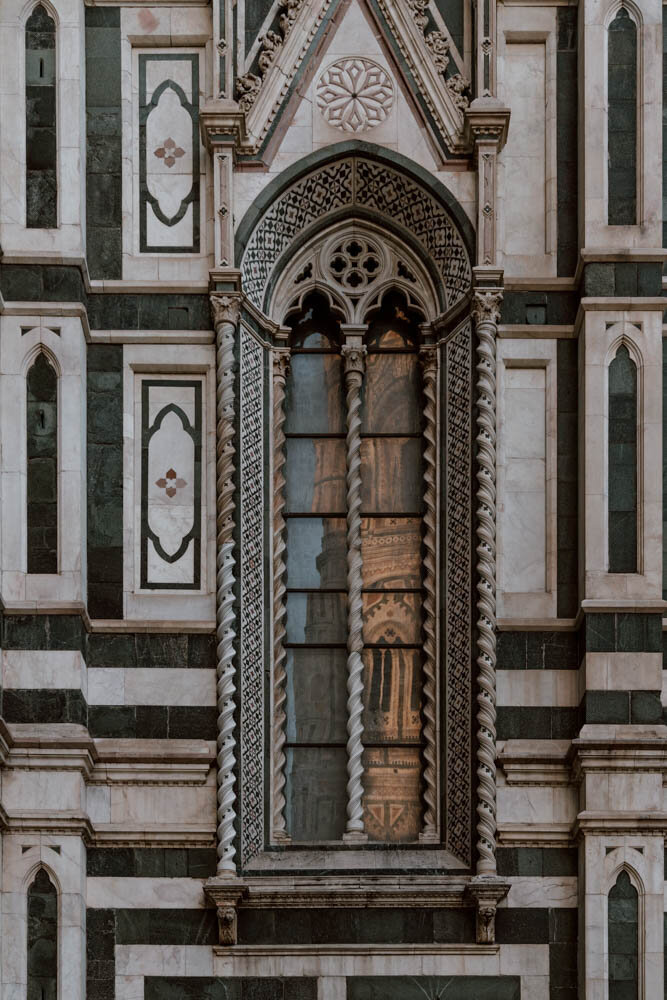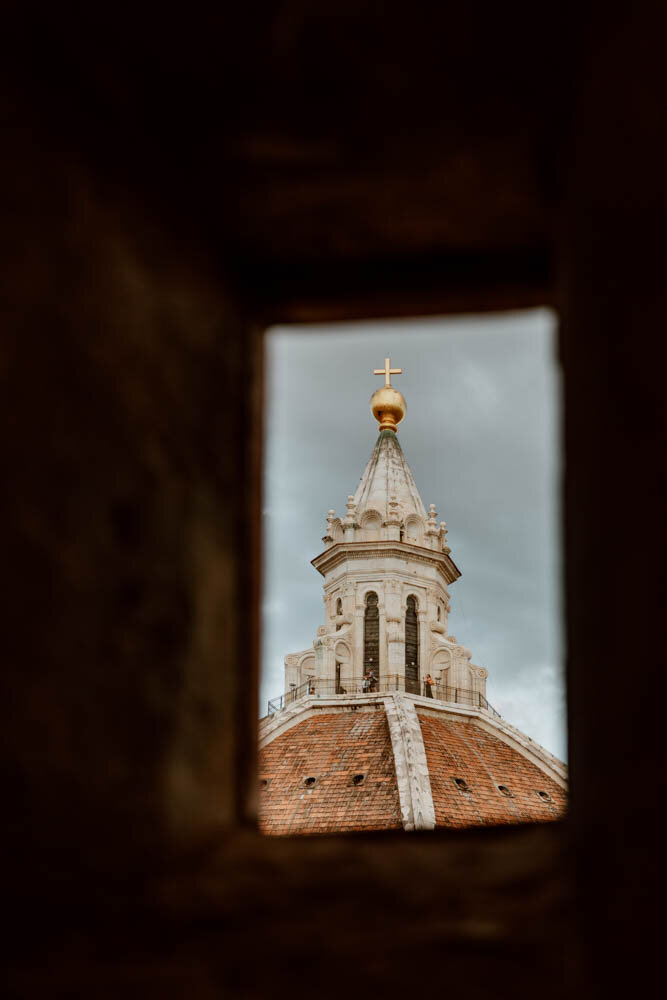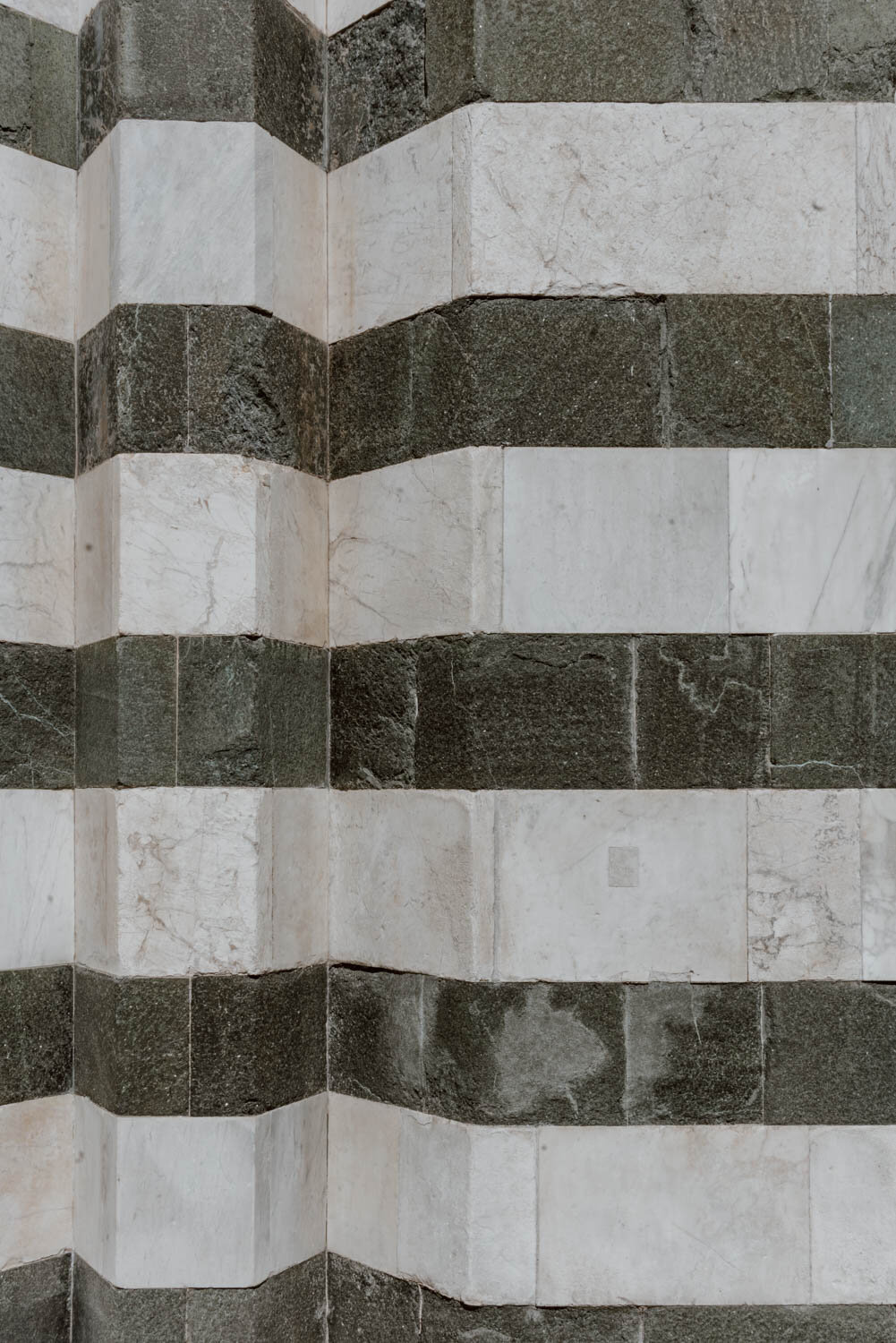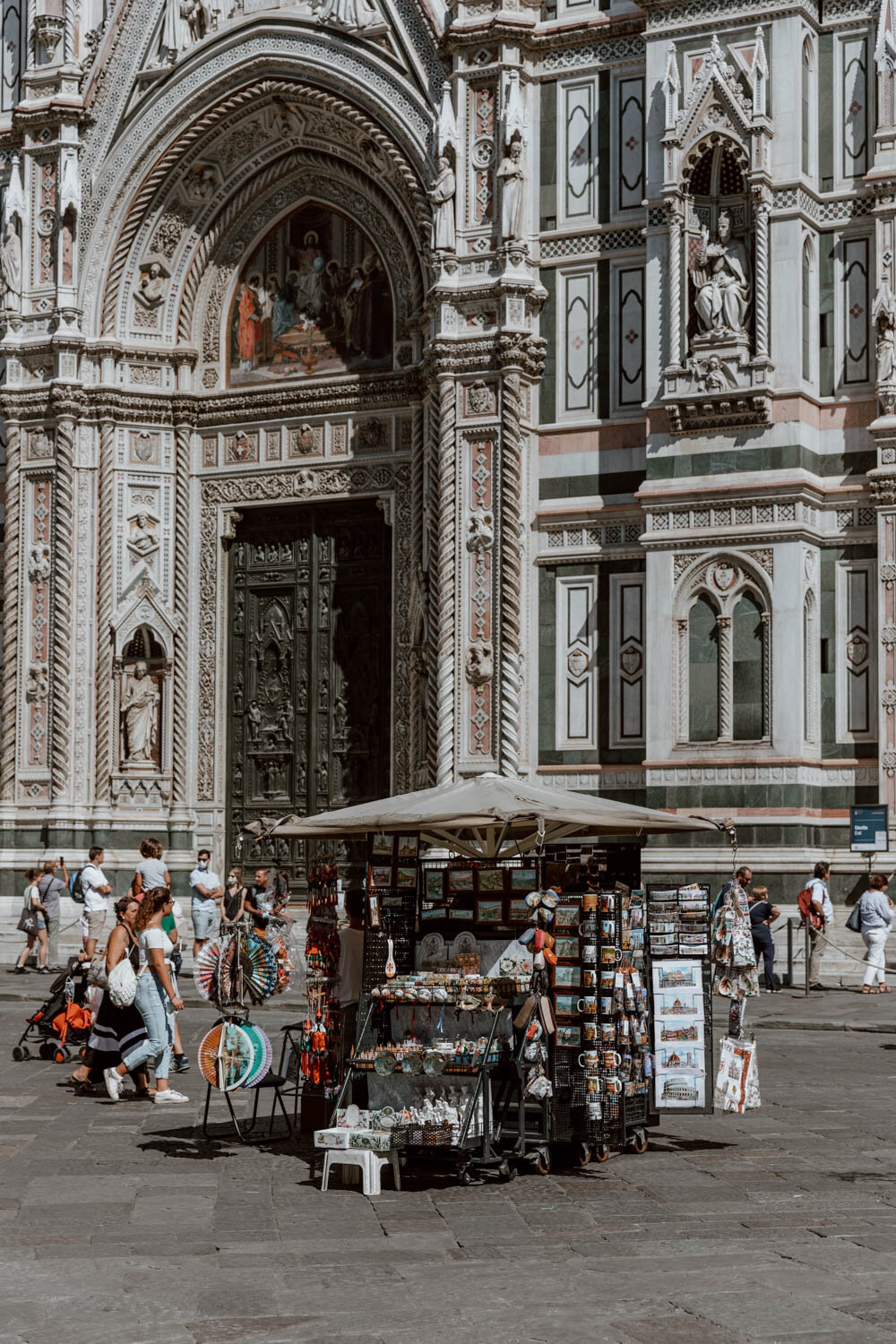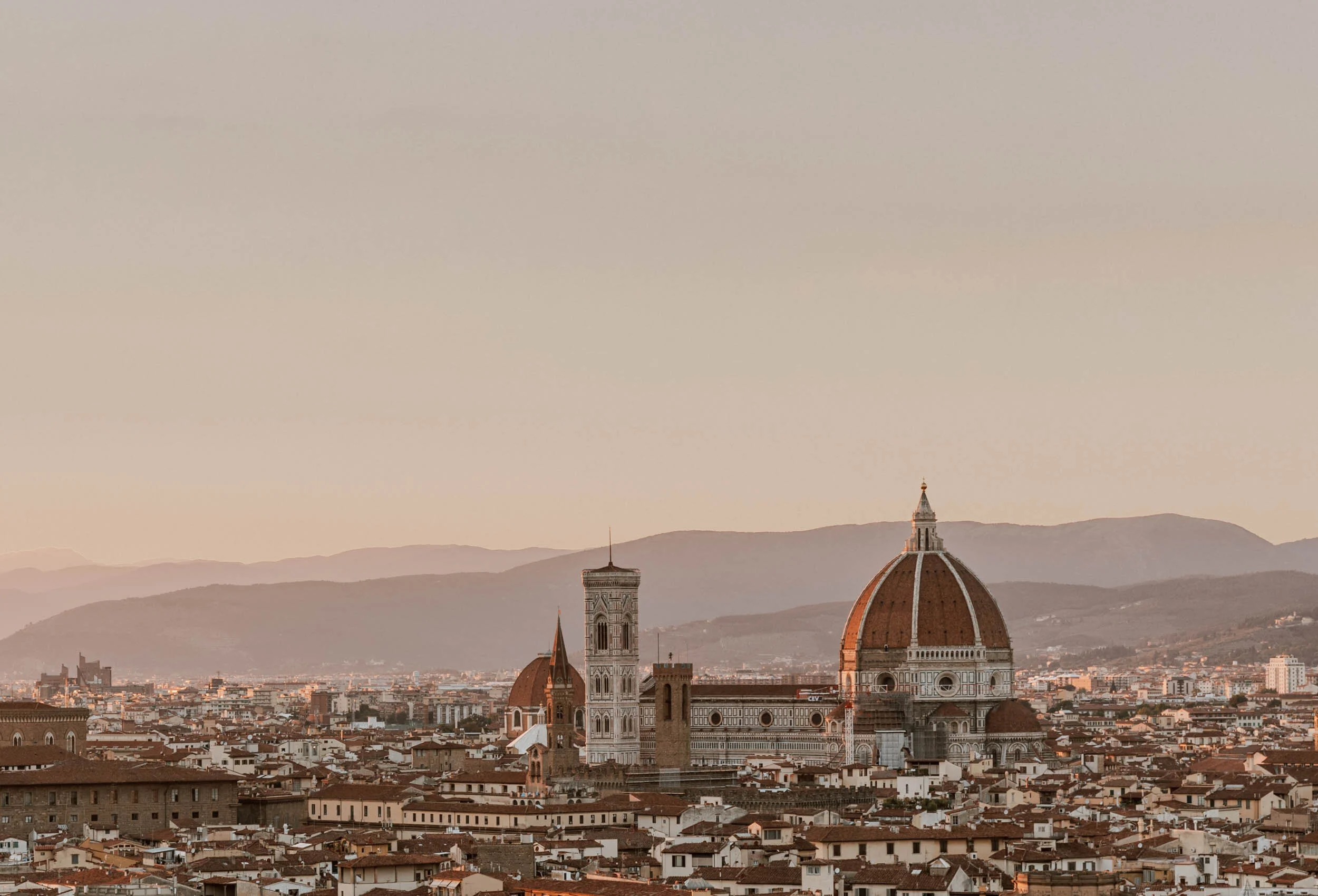Florence Cathedral and the Duomo complex is an integral part of any first time itinerary to Firenze. In this guide you’ll find everything you need to know to plan your visit, as well as some intriguing historical context.
“It is mountainous yet strangely buoyant, as if the white marble ridges rising to its apex are ropes holding a zeppelin to Earth. Somehow Brunelleschi captured freedom in stone, exalting the Florentine skyline ever after with an upward-yearning embodiment of the human spirit.”
Based upon the designs of Siennese architect Arnolfo di Cambio, the construction of Florence's Cathedral began in 1294. Yet it was not until 1418 that those in charge addressed a significant flaw: the monumental cathedral, designed to showcase the city's cultural status, was still without a roof.
At 45m across, and beginning 54m above the ground, the magnificent cupola was to be the largest dome ever constructed. However, the desire to avoid external arches and gothic design (this was to be a Renaissance masterpiece after all) meant that - perhaps somewhat embarrassingly - nobody knew quite how to build it.
Architects were keenly aware of countless examples of huge concrete circular domes in Italian history (such as the Pantheon in Rome), but the recipe for concrete was lost in the dark ages and, even with it, there was unlikely enough timber in Tuscany to manufacture the required scaffolding for a dome that began so far off the ground. It wasn't even clear if the existing structure could support a cupola of this size without collapsing the structure beneath.
With their unfinished cathedral and impossible dreams, the fathers of Florence risked looking like fools; and so came about a competition that would change the city's skyline forever.
Open to all members of the public, and attracting the crème de la crème of the region’s architects, it came as somewhat of a surprise to all - including the overseers - when the commission was handed to Filippo Brunelleschi, a relatively unknown genius (and a goldsmith, not an architect) with a secret plan.
Without the costly requirement of scaffolding, his vision was to construct a dome within a dome; that is, an inner shell made of sandstone and marble and an outer shell made of brick and mortar - each individually designed, shaped and fired to support the dome perfectly.
On March 25, 1436, Pope Eugenius IV consecrated the finished cathedral, to a soundtrack of tolling bells and the cheers of proud Florentines; in 16 years Brunelleschi had achieved something many in Florence never thought possible and created an icon whose image has echoed across the world for centuries.
The unknown had created a masterpiece atop a masterpiece; "a dome so large and notable that after it was built, its name came to be synonymous with the church itself (“Il Duomo”)."
//
Follow the throngs of tourists that descend upon one of Italy's most famous cities, and you will quickly be swept atop a wave towards Piazza del Duomo, the name given to the central square that contains one of Florence's most-prized possessions.
Containing the Cathedral of Santa Maria del Fiore, Giotto’s Campanile (Bell Tower), the Baptistry of San Giovanni, Crypt of Santa Reparata and the Opera Museum it offers even the most inquisitive and fastidious tourist hours of artistic, historical, and intellectual entertainment.
And whilst recent changes to ticket pricing (more on that later), mean that many of you will have to be a little pickier about which you enter or climb, you will likely still find yourself returning time and time again to the vast monastical complex.
It is breathtaking.
In this guide we will cover the various attractions within the piazza, as well as our personal tips for those you absolutely can't miss, the new changes to tickets (and how to buy them) as well as recommendations for guided tours. We’ll also share advice for choosing between a climb to the top of the duomo or the campanile’s viewpoint in the heavens!
the essentials
// The Duomo Complex is the jewel in Florence’s crown.
// Tickets should be bought in advance online.
// Significant price increases in 2020/21.
// Amazing viewpoints available from two areas.
Buying Tickets for Florence Cathedral and the Duomo Complex
It’s completely free to stroll into the Piazza del Duomo (Google Maps) from various side street offshoots to admire the buildings and walk around them. However, if you want to go up to the famous viewpoints or enter the majority of the buildings within the Duomo complex, you need to buy a ticket.
Prior to 2020, it was possible to buy one single ticket (€18 valid for 72 hours) that covered entry to all areas of the Duomo complex. However, with new limits on visitor numbers and the need to ensure social distancing, you are now required to purchase individual tickets for all attractions besides the cathedral, which has remained free of charge to enter. Tickets for all are limited to a certain time slot and visit duration.
Unfortunately, this shift has resulted in hugely increased prices, with entry to Brunelleschi’s Dome alone now costing more than the original combined ticket (meaning our own visits last summer cost a lot more than we had budgeted!). This arrangement will hopefully change in future once the world returns to normal (and we’ll of course update the post), but it’s likely to be here for a while yet.
Ticket prices for 2021
Brunelleschi’s Dome | €20 (€10, children 7-14)
Giotto’s Campanile | €15 per adult, €7 for children between 7 and 14. €15 (€7, children 7-14)
Opera del Duomo Museum and Baptistery (combined ticket) | €10 (€5, children 7-14)
The Duomo Terraces (only accessible as part of guided tour) | €25 (€10 children 7-14)
If you’re on a budget or (understandably) balking at the total bill to visit all of the above, then you will have to pick and choose which of the attractions to visit beyond the cathedral.
Where to Buy Your Ticket
A quick internet search of ‘Florence cathedral tickets’ will reveal a great number of third party websites offering tickets to the Duomo and its nearby attractions. The catch is that it can be difficult to establish just between the genuine, official distributors and the nefarious marker-uppers.
Now, whilst these third-parties are selling genuine tickets, there really is no need to book through them for the Duomo complex; instead just go and book directly via the official website. You will get an e-ticket sent by email, which you can print out or display on your mobile.
However, do note that you are unable to book guided tours (like this small group tour of the Duomo) through the official website. So, if you’re keen to gain a greater understanding the the building and its history, we'd recommend checking out the various tours we have linked to in specific sections below, all of which are carefully selected and highly-rated.
There is also the option to purchase in person from the official ticket office at 7 Piazza San Giovanni (Google Maps). It’s open from 8.15 am to 6:45 pm, but you will have limited availability and options if you buy it on the day you plan to visit.
When to Buy Your Ticket
Should you be keen to visit the Duomo complex during your time in Florence, we highly recommend booking your tickets as soon as possible to ensure availability for your preferred time slot. For example, climbing to the top of Brunelleschi’s Dome is the singular most popular activity in Florence, and tickets have been known to book out a couple of weeks in advance during high season.
With reduced ticket numbers available for the foreseeable future, this may be even more of an issue.
Therefore, book in advance and book soon once you know your dates.
The buildings of the Duomo Complex
Cathedral of Santa Maria del Fiore
Considering the determination of the Florentine fathers to embrace a Renaissance aesthetic for the cathedral's huge dome, you may be a tad surprised to see that the building itself looks altogether more Gothic in its decorative design.
A feature reflective of evolving tastes in the 19th century, the intricate geometric facade is in fact neo-Gothic, using marble cladding quarried from the same sources the first builders used (green stone from Prato, white from Carrara, and red / dusty pink from Maremma). The resulting effect is overwhelmingly impressive, a patchwork quilt of bold design and and many an indulgent flourish.
Once inside the cathedral, one may therefore be surprise to find it is a much more of an austere affair; a sea of free-standing seats, and a vast empty space punctuated by huge marble columns. This is a result of many of the original decorations being moved to the Museo del Duomo.
Look up however, and you’ll find several iconic frescoes that remain remarkably intact, most notably Giorgio Vasari’s ‘Last Judgement’, which covers the entirety of the dome. Commissioned in 1572, it was designed to instill both reverence and fear among the congregation, expertly combining themes from Dante’s Divine Comedy with traditional Catholic teaching.
Entry | It is free to enter the cathedral and no ticket is required, you will simply need to queue outside and wait your turn to enter. Queues however can be very, very long, so your best bet to cut down waiting time is to go in the early morning. Note that the cathedral building is absolutely gigantic, and it actually takes quite a few minutes to circumnavigate it or go from the back to the entrance door at the front facade (Google Maps)
Tip | As throughout Italy, be aware that this is a spiritual building and active place of worship. Act in a respectful manner, remove your hat upon entry, and wear appropriate clothing (i.e. covered shoulders).
BRUNELLESCHI'S DOME
As impressive as the entire complex is, there is unlikely little doubt in visitors’, historians’, art aficionados’ and indeed Florentines’ minds that without Brunelleschi’s Dome, Florence would not be, well, Florence.
The giant cupola dominates the skyline from all vantage points and casts a looming shadow across much of the old town; to spend time in Florence without getting a first-hand look at the work of Sienna’s architectural genius would be criminal.
Yet whilst many satisfy themselves with viewpoints and walkarounds, for a truly immersive experience of the Brunelleschi’s work, one needs to climb the narrow 463 steps to the very top.
Yes, it can be hard going in the heat, and probably not a great idea if you’re fairly unfit, claustrophobic, or suffer from vertigo or reduced mobility, but the 360˚ open-air views out over the orange rooftops of Firenze and the Tuscan countryside beyond are nothing short of outstanding.
If you buy a ticket for one thing within the Duomo complex, make sure it’s this.
Top Tip | Although it is possible to head up the Dome all day, we would highly recommend booking a time slot around the golden hour (from around an hour before sunset). The view is wonderful irrespective, but watching everything glow burnt orange under the setting sun is simply magical. Also, take time to appreciate your unique perspective and proximity to Vasari’s ‘Last Judgement’ on the way down.
Entry | Tickets should be bought in advance from the official website. The prices are €20, or €10 for children between 7 and 14. It is incredibly important to note that the popularity of the Dome cannot be overestimated, and even in the winter we’ve heard of tickets booking out several days in advance. We’d recommend purchasing your tickets as soon as you know your dates to avoid disappointment - especially if you want to climb up to the top for sunset.
Note that entry point for Brunelleschi’s Dome is not at the cathedral entrance, but rather on the other side in a little side door. It’s really common for people to get mixed up, but just take a good look at the various little signposts outside the cathedral which will point you in the right direction (and make sure you arrive with a few minutes to spare).
Factor in an hour for your visit.
Tours
Private | This three hour VIP tour has exceptional reviews, and includes guided visits to the Baptistery of San Giovanni, the Cathedral, the Crypt of Santa Reparata and Giotto's Bell Tower as well as the opportunity to climb to the top of Brunelleschi’s Dome.
Group | This popular and highly-rated 75 minute tour includes a local guide and your skip-the-line ticket to climb the cupola.
If you would like to know more about the story behind Brunelleschi’s Dome, and why it is so highly regarded, this article is a good read.
Giotto’s Campanile (Bell Tower)
Built in the 14th century, and clad in the same green, white and red marble found on the cathedral, it is said that the 85-metre Giotto’s Bell Tower was constructed more for beauty than function; true to that, its elegant design and intricate carvings have led many to consider it the finest in all of Italy.
We ourselves spent an age, gazing upwards into the sky at this highly decorative structure, the tower made all the more beautiful set in front of a perfect summer sky. For us however, the real joy of this famous campanile - the spectacular views over the city - can only be found from the top.
With only 414 steps (as compared to the nearly 500 to reach the pinnacle of the Duomo), this is a slightly easier climb although we’d still advise that those with mobility or health issues may struggle. It is not as cramped or claustrophobic either, with more open air available and various levels you can stop at for a breather.
Important to Know | We ourselves were somewhat disappointed to discover upon reaching the top that there was metal fencing enclosing the top of the tower. This makes perfect sense from a health & safety perspective, but as photographers, we can’t help but admit to being a little disappointed that securing images would be so tricky - especially given the spectacular vista back on to Brunelleschi’s Dome.
Entry | Tickets should be bought in advance from the official website. The prices are €15, or €7 for children between 7 and 14. Although not quite as popular as the Dome, tickets should ideally be bought in advance - especially if you’d like to go up the tower during the evening or around sunset when it is at its busiest.
Tours
The following tours include a guided visit to the top of are a number of tours that in addition to other monuments within the complex, also include a guided visit to Gitotto’s Campanile.
Private Tour | This three hour VIP tour has exceptional reviews, and includes guided visits to the Baptistery of San Giovanni, the Cathedral, the Crypt of Santa Reparata, the Brunelleschi’s Dome and Giotto's Bell Tower.
Group Tour | If you’d prefer to join a like-minded group, this two hour monument tour is also highly rated and includes a guided visit through the Cathedral (as well as the Crypt of Santa Reparata) and climb up Giotto's Bell Tower and Brunelleschi's Dome.
The Baptistry of San Giovanni
Whilst some historians believe that this was once a Roman temple dedicated to Mars, quite when, how or by whom the baptistry originally appeared is a matter of historical mystery. One thing we do know is that is that it was consecrated as a baptistry in 1128, and as such is the oldest (and one of the most impressive) religious monuments in Florence - even Dante was baptised here!
Inside, visitors will find vibrant mosaics adorning the dome, and works of art heavy with historical and religious associations, however it is its external decoration for which the baptistry is most famous. That is, its remarkable trio of splendid bronze doors.
Cast by sculptor Andrea Pisano between 1330 and 1336, and depicting the life of St John the Baptist, the South Door is the oldest, followed the North Door designed by Lorenzo Ghiberti and telling the story of the New Testament.
The East Door - which Michelangelo dubbed the ‘Gates of Paradise’ - were also designed by Ghiberti, and are considered to be his most famous masterpiece, taking him 27 years to complete.
Do note that given magnitude of these great works, the originals are housed within the Opera del Duomo museum, however the reproductions put in their place are remarkable.
Entry | Tickets to enter the Baptistry (Google Maps) are part of a combined ticket that also allows you to enter the Opera del Duomo. The price is €10 for adults, and €5 for children between 7 and 14.
Tours
Private | This three hour VIP tour has exceptional reviews, and includes guided visits to the Baptistery of San Giovanni, the Cathedral, the Crypt of Santa Reparata, the Brunelleschi’s Dome and Giotto's Bell Tower.
Group | This highly rated 2.5 hour small guided tour is one of the few group tours that visit the Baptistry. Also includes time in the cathedral and skip-the-line entry to the Dome.
Crypt of Santa Reparata
Prior to the construction of the cathedral, it was another - much more modest church - that stood in its place, the remains of which were brought to light during excavations between 1965 to 1973.
What was found by archeologists provided some insight into Early Christianity in the city and the oldest definitive evidence of a Christian place of worship in Florence (the basilica's foundations can be traced back to 405AD)
Sitting directly below the present day cathedral, visitors can visit these impressively restored remains, replete with intricate mosaics, still standing pillars and even the tomb of Brunelleschi himself, the 'old church' having been used as a crypt following completion of the Duomo.
Tours
Private | This three hour VIP tour has exceptional reviews, and includes guided visits to the Baptistery of San Giovanni, the Cathedral, the Crypt of Santa Reparata, the Brunelleschi’s Dome and Giotto's Bell Tower.
Group | If you’d prefer to join a group to explore the crypt, this two hour monument tour is highly rated and also includes a guided visit through the Cathedral, and the opportunity to climb Giotto's Bell Tower and Brunelleschi's Dome.
Opera del Duomo Museum
Whilst originally created to oversee the construction of the cathedral and the campanile, following their completion the building was converted into a museum.
Containing many of the interior and exterior paintings, statues and other great works that were once found within the complex, the Opera del Duomo museum (Google Maps) is a place where those with a passion for art can discover the places and artists who gave life to the Renaissance.
Entry | Tickets to enter the museum are part of a combined ticket that also allows you to enter the Baptistery. The price is €10 for adults, and €5 for children between 7 and 14.
Tours
Given the breadth of this collection, art lovers may enjoy a guided tour of the museum in order to fully appreciate it. In this case, we can recommend this small group tour which in addition to a guided visit to the Opera del Duomo also includes a tour of the Baptistery and entry to Brunelleschi's Dome.
Your Next Stop
13 Wonderful Things to Do in Florence
Where to Find the Best Views of Florence
A Moment With Michelangelo’s David
Florence’s Top Museums
23 Things to Know Before You Visit Florence
Where to Stay in Florence






